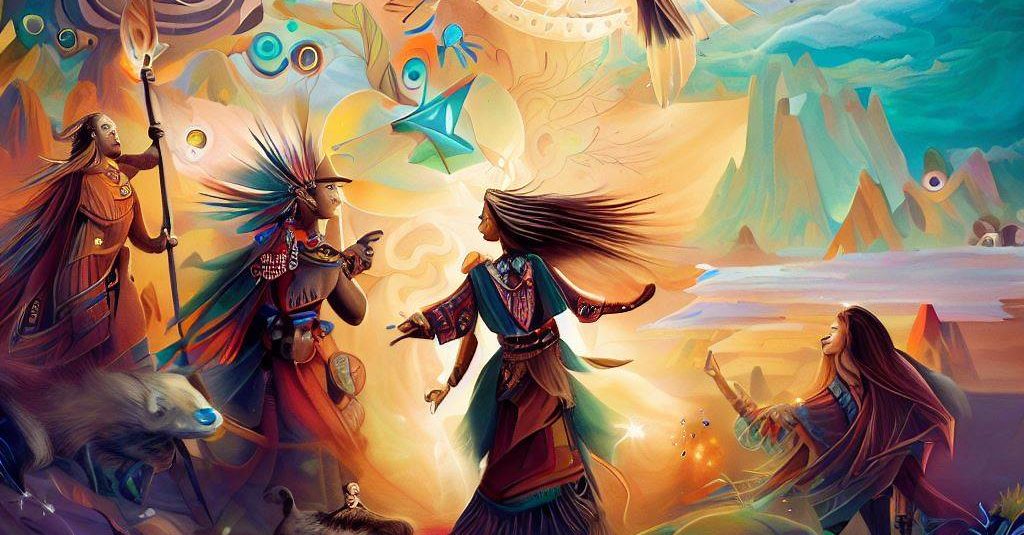Navajo Origin Story: A Journey Through Time, Space, and Spiritual Realms
The Navajo origin story is an intricate and multifaceted narrative that not only explains the creation of the Navajo people but also serves as a foundation for their cultural, spiritual, and social beliefs. The story encompasses a series of complex events and characters that traverse different realms of existence, from the First World to the emergence into the Fourth World, where the Navajo people currently reside. This article delves into the Navajo origin story, examining its themes, characters, and the significance of these elements in the broader context of Native American history and interconnectedness.
The First World: Ni’hodilqil
The Navajo origin story begins in the First World, Ni’hodilqil, a dark and barren realm inhabited by four spiritual beings: the Black Yei (Yéʼiitsoh), the White Yei (Yéʼiitsoh Sikaadí), the Blue Yei (Yéʼiitsoh Dootłʼizh), and the Yellow Yei (Yéʼiitsoh łigai). Each of these beings represents a cardinal direction, an essential element, and a color, reflecting the Navajo belief in the importance of balance, harmony, and interconnectedness in the world.
The Second World: Ni’hodootł’izh
The narrative progresses to the Second World, Ni’hodootł’izh, where the spiritual beings encounter various animal and insect beings, including the Swallow People, the Spider People, and the Bat People. The inhabitants of the Second World are organized into different clans and are governed by a complex social structure. The spiritual beings and the inhabitants of the Second World coexist peacefully until conflict arises, prompting the spiritual beings to depart and ascend into the Third World.
The Third World: Ni’hodisxós
Upon entering the Third World, Ni’hodisxós, the spiritual beings encounter the Pueblo people, who have developed a sophisticated society centered around agriculture and communal living. The spiritual beings learn from the Pueblo people, adopting agricultural practices, art, and religious elements from the Pueblo culture.
It is in the Third World that the spiritual beings create the first Navajo people from maize and sacred materials. They mold the first man, Áłtsé Hastiin (First Man), and the first woman, Áłtsé Asdzáá (First Woman), and bless them with the ability to procreate, leading to the emergence of the first Navajo clans.
The Fourth World: Ni’hodisxóstłʼish
The Navajo people, along with the spiritual beings, then make their way to the Fourth World, Ni’hodisxóstłʼish, through a hollow reed, guided by the guidance of holy beings. The emergence into the Fourth World marks the beginning of the Navajo people’s journey to find their true home. The Fourth World represents the Earth as we know it today, where the Navajo people establish their homeland, Dinétah, in the Four Corners region of the United States.
Interconnectedness with Other Native American Tribes and Cultures
The Navajo origin story shares similarities with the creation myths and narratives of other Native American tribes, reflecting the interconnectedness of their histories, cultures, and experiences. For instance, the emergence from lower worlds to the current world is a common theme in Pueblo, Hopi, and Zuni creation stories, highlighting the shared belief in the existence of multiple realms and the progression of life through these realms. Additionally, the importance of balance, harmony, and the interplay of different elements is also a recurring motif in many Native American cosmologies.
The Navajo origin story also demonstrates the interconnectedness of the Navajo people with their neighboring tribes, such as the Pueblo people, from whom they adopted various cultural and religious practices. This exchange of ideas and beliefs highlights the fluidity of cultural boundaries and the rich tapestry of shared experiences among Native American tribes.
Themes and Significance of the Navajo Origin Story
The Navajo origin story encompasses several themes that are central to the Navajo belief system and cultural identity:
- The importance of balance and harmony: The presence of the four spiritual beings in the First World, each representing a cardinal direction, an element, and a color, underscores the Navajo belief in maintaining balance and harmony within the natural world and the cosmos.
- The role of spiritual beings: The narrative highlights the significant role that spiritual beings play in the creation and guidance of the Navajo people, emphasizing the strong connection between the spiritual realm and the physical world in Navajo culture.
- The journey toward self-discovery and belonging: The emergence into the Fourth World and the subsequent search for the Navajo homeland, Dinétah, represent a journey of self-discovery and the importance of establishing a sense of belonging and rootedness in the world.
- Interconnectedness and cultural exchange: The Navajo origin story showcases the exchange of cultural practices, beliefs, and knowledge between the Navajo people and their neighbors, highlighting the importance of interconnectedness and shared experiences among different tribes and cultures.
The Navajo origin story serves not only as an explanation for the creation of the Navajo people but also as a foundation for their cultural identity, spiritual beliefs, and social organization. By examining this narrative in the context of Native American history and interconnectedness, we can gain a deeper understanding of the rich tapestry of experiences, beliefs, and practices that shape the diverse cultures of the indigenous peoples of North America.
Bibliography
- Kluckhohn, C., & Leighton, D. (1974). The Navaho. Cambridge, MA: Harvard University Press.
The Navaho by Clyde Kluckhohn and Dorothea Leighton is an authoritative and comprehensive study of the Navaho Indians, offering insights into their history, culture, and the challenges they face today. Lauded for its interdisciplinary approach and sympathetic, unbiased perspective, this book is a valuable resource for those interested in the Navaho people, anthropology, sociology, or race relations. - Luckert, K. W. (1991). Navajo Mountain and Rainbow Bridge Religion. Flagstaff, AZ: Museum of Northern Arizona Press.
Navajo Mountain and Rainbow Bridge Religion, written by Karl W. Luckert, is the first volume in the American Tribal Religions Series, published by the Museum of Northern Arizona in 1977. In this fascinating work, Luckert explores the religious significance of the Rainbow Bridge rock formation and Navajo Mountain, as well as the cultural impact of the construction of Lake Powell on the Navajo people. - McPherson, R. S. (1992). Sacred Land, Sacred View: Navajo Perceptions of the Four Corners Region. Provo, UT: Brigham Young University Press.
- O’Bryan, A. (1956). The Dîné: Origin Myths of the Navaho Indians. Washington, D.C.: Smithsonian Institution.
- Zolbrod, P. G. (1984). Dine Bahane: The Navajo Creation Story. Albuquerque, NM: University of New Mexico Press.

